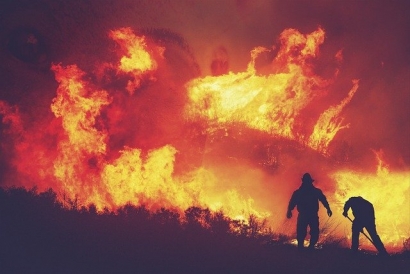
Professionals evaluated a decline in solar panel efficiency rates as the wildfires expanded. With additional research, environmental engineers and scientists can create protective enhancements to maintain optimal outputs. Before evaluating efficiency improvement, we must examine the ecological limitations deriving from wildfires.
Last year, when wildfires also consumed California, researchers recorded a 30% decrease in solar panel efficiency levels. The fires carry minuscule smoke particles throughout the state, decreasing surface-level sun exposure. Though panels can produce electricity on cloudy days and through snowstorms, smoke creates a new challenge.
The small airborne particles block the sun’s energy from reaching panels and generate efficiency-degrading buildup. When trees burn, they produce soot and heavy particles. Wind can carry the ash throughout California, creating a layer of dirt on solar systems.
A team of researchers evaluated the effects of buildup on panels. They discovered clean panels have a 50% higher efficiency rate. When ash cakes up on systems, it reduces sun exposure, limiting production.
As wildfires burn down trees, they increase a panel’s potential exposure to direct sunlight. If solar systems were fire-proof, the tree removal method would benefit energy production rates. Unfortunately, panels produce adverse ecological effects when burned.
Panels and batteries contain harmful chemicals, creating toxic fumes in fires. They also restrict necessary entry points for firefighters, reducing one’s ability to extinguish a home. The system adds additional weight to a structure’s roof, increasing its risk of collapsing during a natural disaster.
Burning and air pollution generates harmful effects on local species. Thick smoke restricts some animals’ ability to flee from dangerous regions. Fires may also demolish their habitats, food supplies and protective resources.
Conventional solar panels can generate more harm than good during wildfires. Researchers are developing fire-resistant technology, decreasing a panel’s contribution to environmental degradation. If we can limit the spread of a wildfire, we can conserve drought-ridden regions like California by creating non-flammable devices.
Environmental scientists created a high heat-resistant material,improving the efficiency of panels as Earth’s temperature rises. Engineers can use similar science and technology, creating a non-flammable system. Improving panel materials and installation processes can decrease the spread of wildfires.
Properly installing rooftop panels can significantly decrease their risk of catching on fire. Individuals can ensure the safety of a system by adequately managing its wires, using the same brand connectors and applying the correct crimping tools. It is also important to evaluate an installation professional’s credentials before hiring them.
Engineers are also developing self-cleaning panel technology, increasing efficiency levels during wildfires. The anisotropic ratchet conveyors (ARCs) remove buildup on and preserve the longevity of a solar system. Increasing the efficiency of renewable power production during natural disasters can enhance residential safety and prevent additional pollution development.
Solar panel owners can engage in protective maintenance, decreasing the deficiency effects from fires. They can start by preserving the efficiency of a property, increasing solar power production. If residents are having a summer bonfire in inactive wildfire regions, they can utilize dry wood.
Wet wood generates more smoke and efficiency-degrading soot. Kiln-dried logs produce the least amount of ash, preserving your property’s solar panels. Owners can also improve energy production rates by frequently cleaning their systems.
Before adding products to your panels, you can rinse them using a traditional garden hose. If soot and dust remain after you hose them down, you can utilize warm water with a few drops of soap. You can apply and scrub the solution onto the surface using a soft cloth.
Owners may then rinse the soap from the panels and watch their efficiency levels rise. You can repeat the process multiple times a week or month, depending on the severity of the wildfires. Spraying water on your panels also cools them down, preventing the efficiency-degrading effects of overheating.
As the climate continuously changes, researchers expect the energy sector to respond. California relies on emission-less electricity sources to prevent further destruction, decreasing the global temperature. We may notice fire-resistant advancements in solar panel technology soon reach the market.

